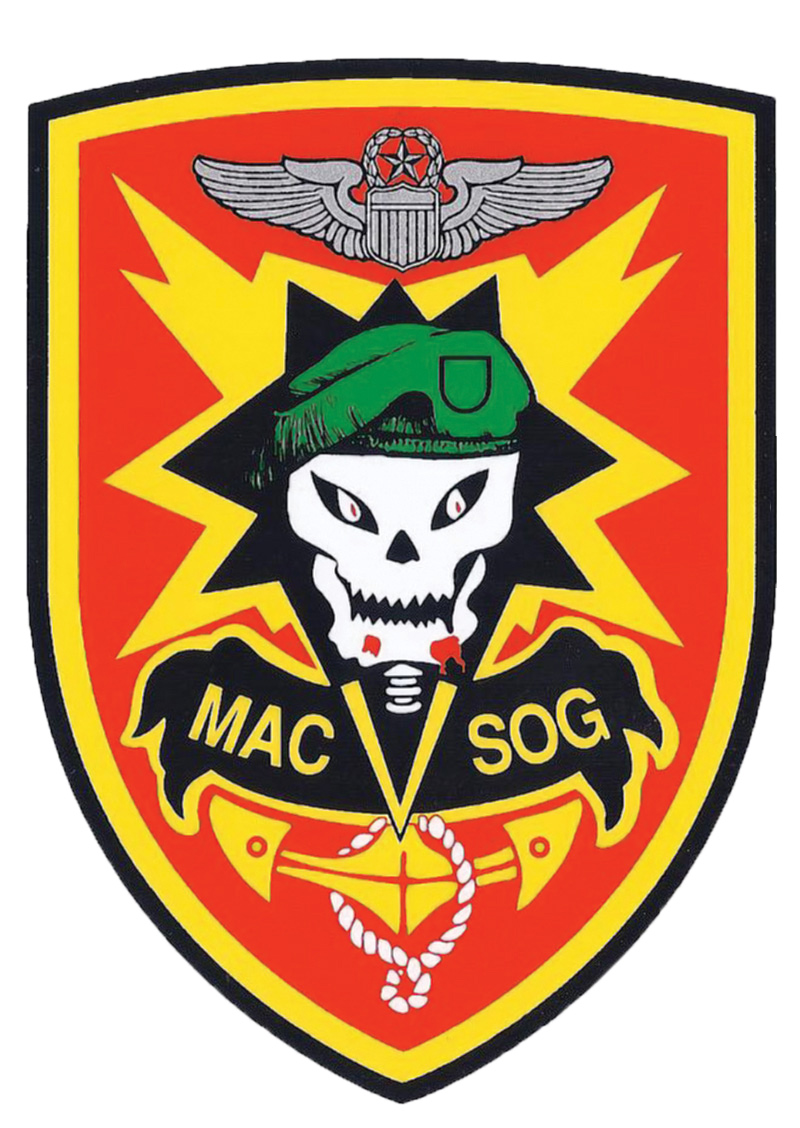
MACV-SOG
One-Zero School
Part III in the Series:
Class One Implementation
By Travis Mills
Originally published in the May 2018 Sentinel
Introduction
That first cycle was a definite “work in progress.” As with all startups, there were things we had not anticipated and we had to do some fast adjustments, but all in all things went pretty well. The students were quite impressed with the instructor’s (1-0’s & 1-1’s) knowledge and experience and the sharing of their on the ground experiences. It was literally War Stories 101! The student’s enthusiasm was high and often at the end of a session, the students didn’t want to take a break. They were tremendously eager to soak up every ounce of knowledge. We were off to a great start.
Surprise Visitors
About the third day, there was a big commotion at the front gate. It seems that COL Cavanaugh (Chief SOG), and COL Johnson (Chief, OP 35), and some of the staff had come to check on their special project. Obviously their presence caused a great deal of anxiety and scurrying around in the entire camp. They came to the class in session and stood in the back of the classroom. I reported to them and explained what was going on in the class. Both of them wanted to address the class, so I signaled the instructor to “hold up.”
I introduced COL Cavanaugh, he made a brief talk about the importance of the SOG mission and this school was the first of its kind and their (the students) missions were tremendously important and the intelligence they gathered went through SOG Hq. straight to the Pentagon and White House. He thanked them for volunteering to be an integral part of SOG.
I then introduced COL Johnson. While COL Cavanaugh was the epitome of a polished commander, COL Johnson had the personality of charging bull elephant! He went straight to the point — “this is the most difficult assignment you will ever have and we (SOG Hq.) are going to push you to the limit. If you have any trepidation about being in this unit, get out now. You are of the linage of the Jedburgh Teams of WWII and we will expect and demand nothing less from you. Take heed of these instructors, they have been on the ground and looked death in the face. If you chose to stay — I salute you and Good Luck!”
With that, they exited the classroom. It was quiet! The students were in awe, the two top officers of SOG had just taken the time to come to this camp and address them personally.
I motioned the instructor to continue the class and followed the VIP’s outside. This particular class had been about commo and we only had 3 radios for the 20+ students. Both COL Johnson and COL Cavanaugh questioned me about that. I explained we had made our requests but this is what we were given. (From being an S-4 in the 7th Group, I knew to document requests and keep the paperwork. I retrieved it along with the terse note from SOG 4 about “make do with what you get”). They took the paperwork and in a few minutes were on their way back to Pasteur Street in Saigon.
We continued the scheduled training and I was hoping I would still be a 1LT tomorrow morning. This all happened between 1000 – 1200 hrs. We continued with the scheduled training for the rest of the day. Even though the students had been very enthusiastic before, they were really charged up the rest of the day.
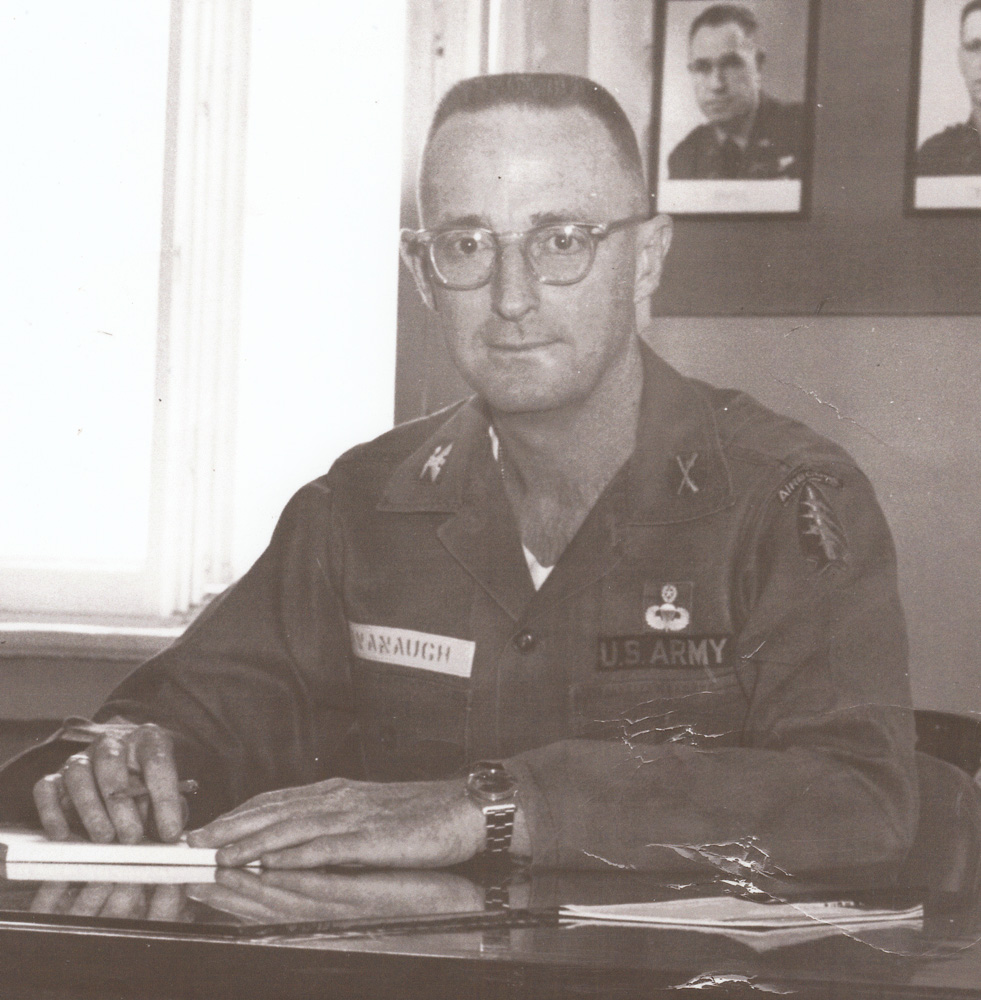
Stephen E. Cavanaugh Jr.—early army days
More Surprises at the Front Gate
Just as we were ending the training for the day, there was another big commotion at the front gate. One of guards came to find me and said I need to come to the gate immediately. I went to the gate and there were two 2 half-ton trucks. The SGT in charge said he needed to talk to 1LT Mills. He told me he could not go back to Saigon until he had a signed receipt from me saying I had received this shipment.
To my amazement it was everything I had listed in my original equipment request, plus a few things that COL Cavanaugh and COL Johnson thought we might need. Apparently they did not go back to Pasteur Street, but went straight to SOG 4 at Ton San Nhut and emphasized to them Chief SOG’s priority of the 1-0 School. Everything on that request was to be delivered TODAY! No exceptions! Also included was a copy of a letter from Chief SOG with an endorsement from Chief OP 35 to all FOB Commanders of the priority of the 1-0 School. It was great that we had such an endorsement from Chief SOG, but on the other side was now we have to REALLY PRODUCE!
We continued the cycle, again with some adjustments as we went along due to it being the first time through. With the strong endorsement from SOG Hq. I took the chance and went to Saigon to make one more request. That was for helicopter support for McGuire Rig training. I requested and was allowed to speak to both COL Cavanaugh and COL Johnson and pleaded my case about the importance of McGuire rig training and getting helicopter support for a few hours.
I went through my story to emphasize the importance of the training. Both of them commented they had read the AAR and had not realized that had been me. Both agreed that McGuire rig training was important and an integral part of the training. I told them I knew we (SOG) had an H-34 at Ton San Nhut to ferry VIP’s, etc., and the crew spent most of their time in the day room playing cards. I only wanted 4 hours per cycle. They both agreed and said they would make it happen, and they did. During the 2nd week we had McGuire rig training, teaching the students how to rig the ropes in the floor of the helicopter, and each one got to call in the chopper and ride the rigs out of a hole in the trees.
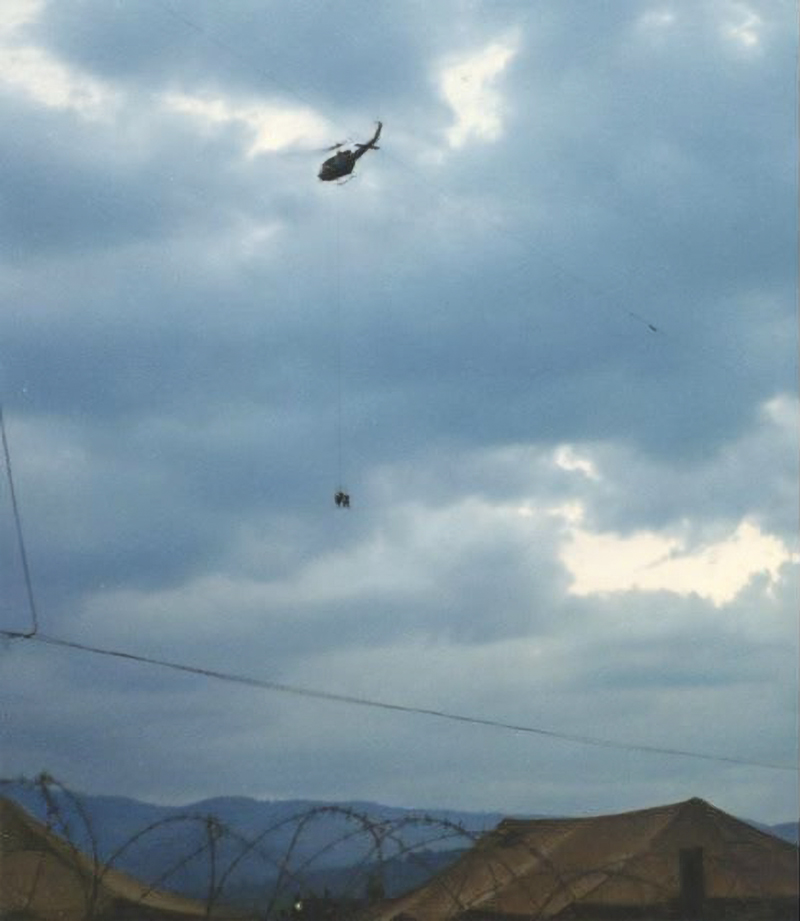
Riding the STABO rigs at B53. (Courtesy of James [Jones] Shorten)
A visit to FOB 2
The rest of the cycle went off without any major incidents. The students continued to be enthusiastic and eager to learn. At the end of the second week, a Blackbird C-123 picked us up at daylight and took us to FOB 2. We arrived at mid-morning and the teams (4 teams of 5 students and an instructor) immediately went to OP Center for mission briefing and launched in mid-afternoon.
FOB 2 OP Center knew we were coming and had planned our targets accordingly and coordinated the air assets, etc. The teams had been supplied at Long Thanh with ammo, claymores, hand grenades, rations, radios, etc. When they arrived they were ready to go, just as if they were going to a launch site.
Even though we did not tell the teams, the targets were not high priority, but they were real targets. Again, as the first time through, it was a learning experience with us (the 1-0 school staff) being in the OP Center/Com Center with the FOB 2 crew. We worked our teams on separate frequencies and separate radios. It was a little chaotic, but by the end of the third day we had developed somewhat of a working model.
Later on we would come up with a better solution, but this model worked for the first few cycles. All 4 teams stayed on the ground for area recon for 4 days (insertion day plus 3 – coming out late afternoon of the 4th day). Once the teams were back at FOB 2, we had debriefings with the instructors doing critiques. Afterward we had a “graduation ceremony” which was a short “You done good” speech and the “highly prized” Zippo lighter with the SOG Crest. We then retired to the club where I bought the first round of drinks (on Chief SOG’s chit). The next morning we were at the airfield to catch the Blackbird milk run; the students back to their FOB and we back to Long Thanh to get ready for the next cycle.
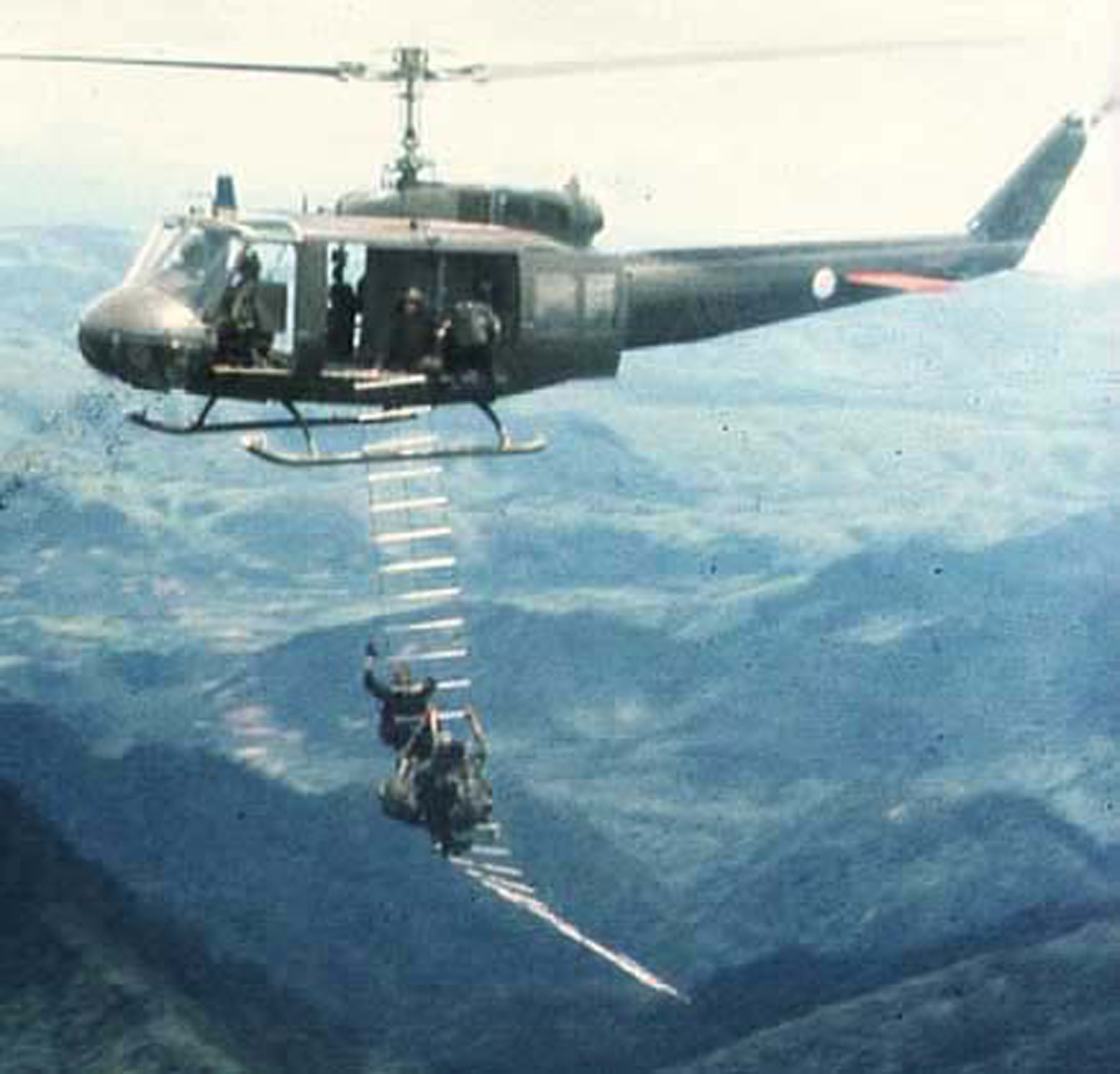
Riding the ladders. Impossible to capture in a photo, but the ladder would swing back and forth—quite a wild ride. The Army Field Manual 90-5 for Jungle Operations instructs that "while on the ladder remain calm at all times."(Courtesy of James [Jones] Shorten)
Second Cycle
When we got back to Long Thanh we were greeted by the new camp OX, MAJ Ponzillo. While we were gone to FOB 2, MAJ Ponzillo had been assigned to the camp. Because Chief SOG had put such a priority on the 1-0 School, the camp commander, MAJ Smathers, had appointed the XO to shepherd to 1-0 School. At first I wasn’t too sure about how this would work out, but soon found that MAJ Ponzillo was a strong supporter of the school. He was an experienced SF officer on his second tour with 5th Group. With his strong support the school staff soon became well integrated into the camp.
The second cycle went well with very few hiccups. MAJ Ponzillo spent a good deal of time monitoring the training and providing assistance. The Long Thanh permanent party personnel were all SF qualified and with coordination from MAJ Ponzillo provided substantial support during the training such as range safety, commo support, training area preparation, medical coverage for live fire exercises, and logistical support.
MAJ Ponzillo went with us to FOB 2 for the student missions. He spent a good deal of his time observing the OP Center operations. But he also spent quite a bit of time talking to various 1-0’s about the students from the first cycle. They felt the school was quite helpful. Because the new guys had been heavily exposed to SOG’s operating techniques during the course, it took a lot less time and effort to get them integrated into the team and become productive members of the team. They also offered some suggestions on some subjects and/or classes to add or modified.
On the way back to Long Thanh, he and I had a long discussion regarding the training and our operational support of the student teams during the student missions. He felt that we did a credible job, but having both us and the FOB 2 staff in the same small area created a very difficult operating environment. He felt we needed to work on finding a better solution and that he had a couple of ideas he wanted to explore when we got back to Long Thanh.
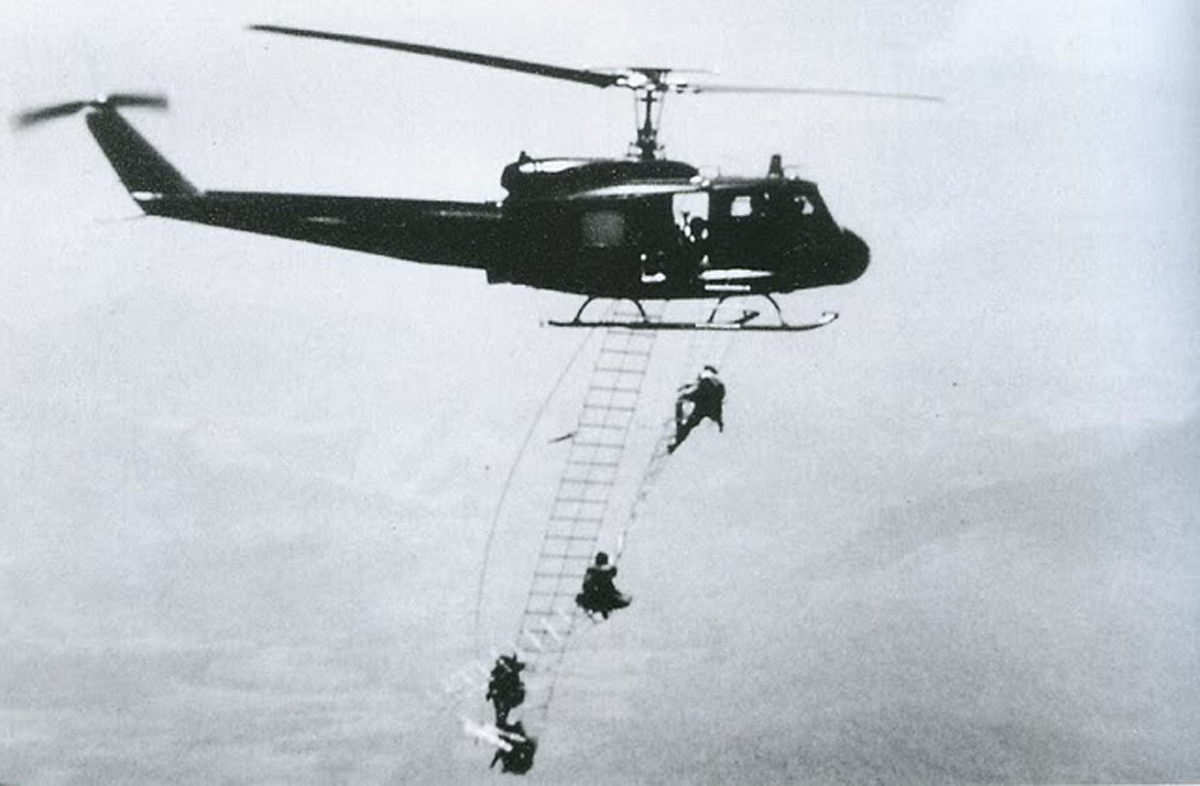
Riding ladders up over 4000' plus. (Courtesy of James [Jones] Shorten)
Back in Long Thanh: New Instructors and Changes
When we got back to Long Thanh the whole area was in turmoil. The 9th Div. was moving out of Bear Cat to a new location. The road from Hwy. 15 to Bear Cat was just a dirt road and there were hundreds of vehicles rumbling up and down the road by our camp. The sky looked like early evening with all the red dust in the air, plus everything in the camp was covered with a thick layer of red dust.
It was during our zero-week, so we were making adjustments to the training schedule, making ammunition and training aid requests, range schedules, etc. Also we were integrating new instructors into the staff. Initially, the 1-0’s and 1-1’s were told they would be on loan to the 1-0 School for “a couple of cycles” then come back to the FOB. As soon as the second cycle was finished, they were on the horn to their FOB’s asking about replacements. So shortly after arriving back at Long Thanh, we started receiving new instructors. Because of COL Cavanaugh’s letter to the FOB’s about the priority of the 1-0 School, we got quality replacements, but there was still the process of getting them integrated into the system.
Bear Cat and the Helicopter
About the second day we got a visit from MAJ Eiland from SOG Hq. He came out to check on the school from time to time and give a report back to COL Cavanaugh and COL Johnson. He had been over to Bear Cat to see what was left at the PX before it was cleaned out. He asked me if we had a rough terrain fork lift and a 5-ton flatbed truck. He told me to get them, with several tie down straps and 4 guys and meet him at the front gate. We met him at the front gate (he had changed into standard fatigues with a baseball cap and MAJ oak leaves) and followed him to the west gate of Bear Cat.
He stopped at the gate and spent a few minutes talking to the gate guards. After a couple of minutes, his jeep went through the gate and the guards waved us through (the fork lift and the truck). We went to an area a couple hundred yards inside the camp. There sat a UH1D helicopter body with the tail boom cut off just behind the engine exhaust outlet. The 9th Div. had used it to train new troops on heliborne assaults. We loaded it on the truck, tied it down and headed for the gate. MAJ Eiland had told them we were from 555 Transport Bn. in Long Binh and were here to transport the helicopter training aid to the new location. When we got to the gate we were not sure it would fit through the gate, so the gate guards helped guide us through (only had about 1 ft. clearance on each side) and gave us a friendly wave as we drove off.
When we got to camp we took it to the motor pool area, off loaded it and covered it with tarps, etc. MAJ Eiland said he had seen it when he was at the PX and thought it would a great training aid for demonstrating how to rig the ropes on the floor for McGuire rig and/or rope extraction. We let it “cool off” for a week or so, then I went to the helicopter maintenance support company at the airfield with 3 cases of San Miguel and got them put in a new floor, D-rings, seats, paint etc. It was a really nice and effective training aid. I don’t think the 9th Div. ever figured out what happened to it. I don’t think they ever considered someone would “steal” a helicopter!
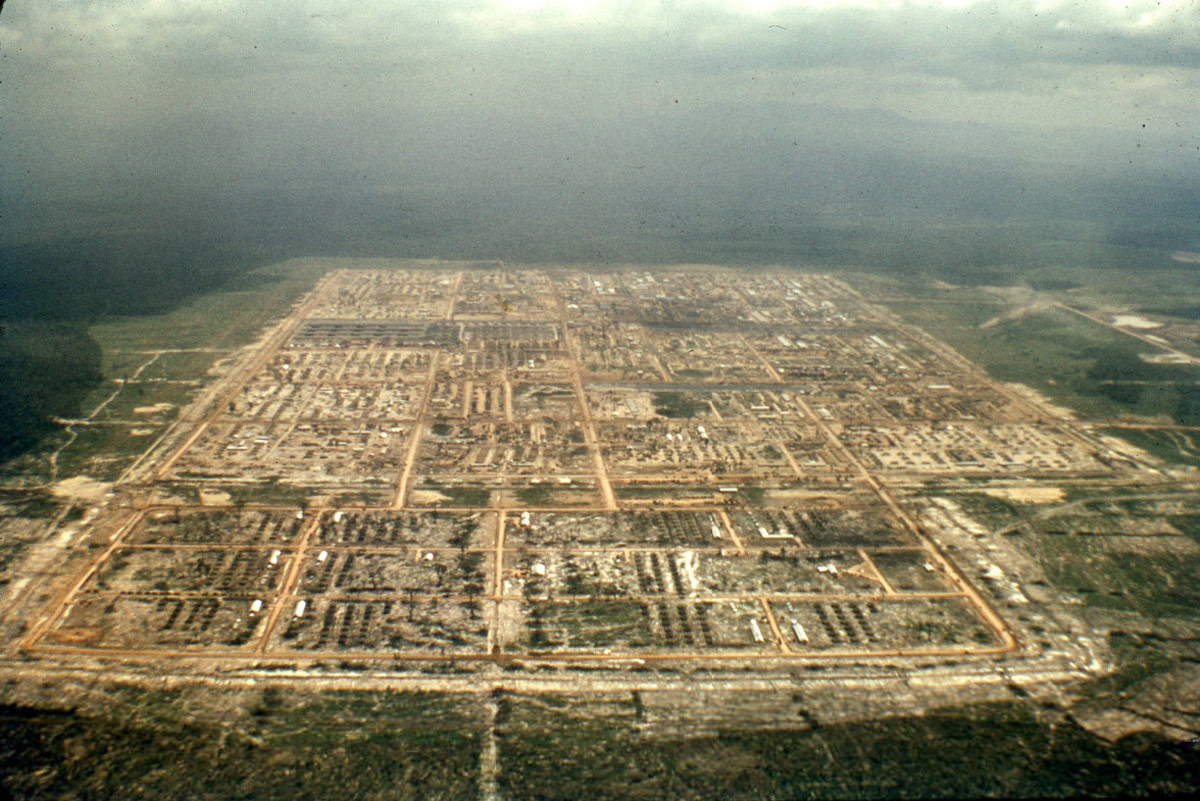
Bearcat Base, September 1967 (By Office of History, Headquarters, U.S. Army Corps of Engineers USACE LNO trip slides Vietnam 9.113
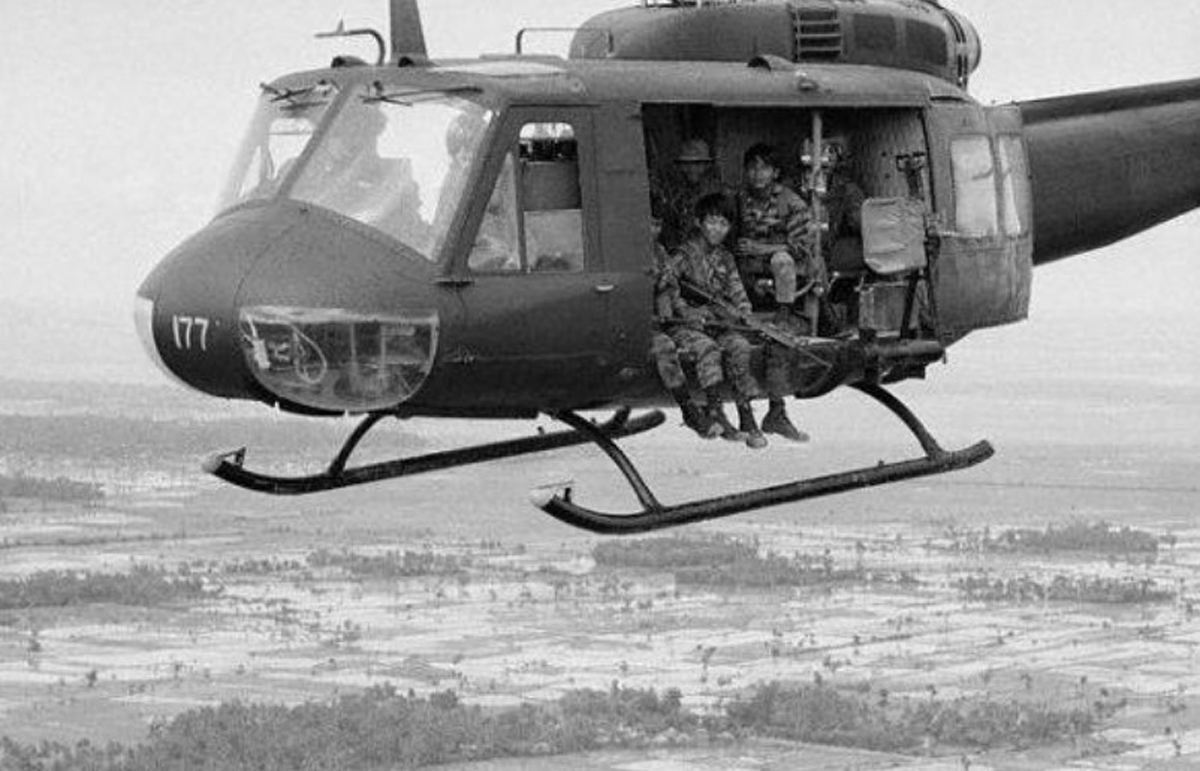
Choppers going in on a training mission (Courtesy of James [Jones] Shorten)
Building a Mobile Communucation/OP Center
Also during that zero-week and the first two weeks of the next cycle, MAJ Ponzillo was quite busy with the commo section and his plan to improve our support capability while at FOB 2 during the student missions. Their plan was to build a mobile communication/OP Center. They took a standard quarter-ton trailer and built a plywood hooch on it.
They filled it with radios, map boards, work space, etc. Basically it was a miniature op/com center. It had FM radios for commo with the teams, covey, etc. It had UHF & VHF radios for aircraft commo, and an AM long range radio so we could talk directly back to Long Thanh. It also had a 16 ft. extendable antenna so we could talk to the teams. It was pulled by a standard three-quarter-ton truck and in the truck bed was a primary and back-up generator. When hooked to the three-quarter-ton truck, the whole thing would easily fit into a Blackbird C-123 or C-130. It was a great piece of equipment.
When we got to the launch site, (later we did launch from sites other than FOB 2), all we had to do was plug into the camp power grid or use our generators if we needed to and we were up and running within 30 minutes of arriving. The Long Thanh commo chief had secured our own operating frequencies, so we didn’t have to worry about interfering with the host camps operating frequencies or interrupting their OP Center. The commo chief always sent one of his staff to take care of any commo equipment issues that might arise. I or one of the instructors not taking a team to the field took shifts to maintain continuous monitoring of the teams as long as they were in the field.
Again, it was a great piece of equipment that gave us a great deal of autonomy as well as not being an unnecessary burden to the host camp. Also it was a strong confirmation of the support of the permanent party staff of Long Thanh to the success of the 1-0 School.
Unexpected Guidance
Toward the end of zero-week I rode into Saigon with the weekly courier to SOG Hq. I asked to speak with COL Johnson to give him an update on the school progress. All was going well, so I decided to make a pitch about me being released and going back to FOB 4 and getting back on a team. COL Johnson listened and in a calm voice said, “You know LT. I know I’m getting old and my memory isn’t as good as it used to be, but (and then his voice went to about 5,000 decibels) I DON’T REMEMBER ASKING YOU WHAT THE HELL YOU WANTED TO DO! THE LAST TIME I READ THE ARMY MANUAL, LT’S DON’T TELL COL’S WHAT THEY WANT TO DO. COL’S TELL LT’S WHAT THE HELL THEY WILL DO! DO YOU UNDERSTAND THAT, OR DO I NEED TO EXPLAIN IT FURTHER”?
I managed a “Yes Sir!”
Then he followed with “Now get your ass back out to Long Thanh and run that school. I will decide if and when you will be released. Dismissed!”
With that I gave a sharp salute, about face and moved out smartly. Once out of his office in the general office area, all the staff was giving me a sly smile and the “welcome to the club” look. I had to wait for a while for the courier to finish his business, so I was just hanging out in the office area when one of the staff told me COL Johnson wanted me back in his office.
I nervously reported back to his office. Surprisingly, he was quite calm and cordial. He motioned for me to sit down and started talking in a “fatherly” tone. He said, “I understand your feelings, I was a young LT. once and know you want to be back in the game. But unfortunately everybody can’t be the quarterback or the star running back; somebody has to block. If I had my way, I would be commanding a Brigade out there kicking ass and taking names. But someone above me assigned me to this staff job for this tour.
“As a professional soldier, my job is to be best damned staff officer I can be and support my commander. As much as you may not like it, it’s your time to be a blocker. Your job now is to make the 1-0 School the best school in this country. Furthermore, you and the instructor staff have the responsibility to give these students the skills that will give them at least a chance of surviving their tour.” He stood up, reached out and shook my hand and said “Now, go on back to the camp and be the best damned blocker you can be.”
I saluted, said “Thank You, Sir — I will do my very best.”
Time to Reflect
During the two-and-half-hour trip back to camp my mind was running at 500 MPH. I kept rehashing what COL Johnson had said about someone has to block, and that we (the 1-0 School staff) had the responsibility to give these students the best training possible so they could have at least a 50/50 chance. I thought back about when I first went to RT Python and wound up being thrown into the breech with little to no RT training or experience. I did have the experience of being in-country for a few months and the experience of some Hatchet Force missions plus sitting in on some of 1-0 sessions in the club.
The students we were getting were predominately on their first tour and new in-country. The FOB’s were being pushed hard to keep teams on the ground and the teams were running missions back to back. These students were most likely going to be on their first mission within a week of getting back to the FOB. The more I thought about it, the more I understood COL Johnson’s statement that it was our responsibility and duty to give these guys our absolute best effort.
Also running through my mind was the “why me” question. I firmly believe everyone who survives a close brush with death occasionally has those thoughts of “how and why did I survive when others didn’t?” Every so often since the August 23rd incident, I would ponder the inevitable question: “Why was I chosen to survive and what is my purpose?” Not only the Aug. 23rd incident, but the hanging upside down from a helicopter at 2,000 ft. Another situation was after I returned from the hospital ship to FOB 4, I was working in S-3 with MAJ Toomey and had I not been picked to go to Long Thanh, in all probability I would have been with him on that helicopter that got blown out of the sky.
The obvious question running through my mind was “Is this where I’m supposed to be?” I have good management and organization skills, along with good instructor skills. By utilizing those skills I, and the other instructors, can have a significant impact on all the FOB’s, and make the biggest contribution to the success of the overall operation by running this school to the best of our ability. By the time we got back to the camp, I knew this was where I was supposed to be and had a new and total commitment to make this the best damned school in Vietnam. I slept well that night.
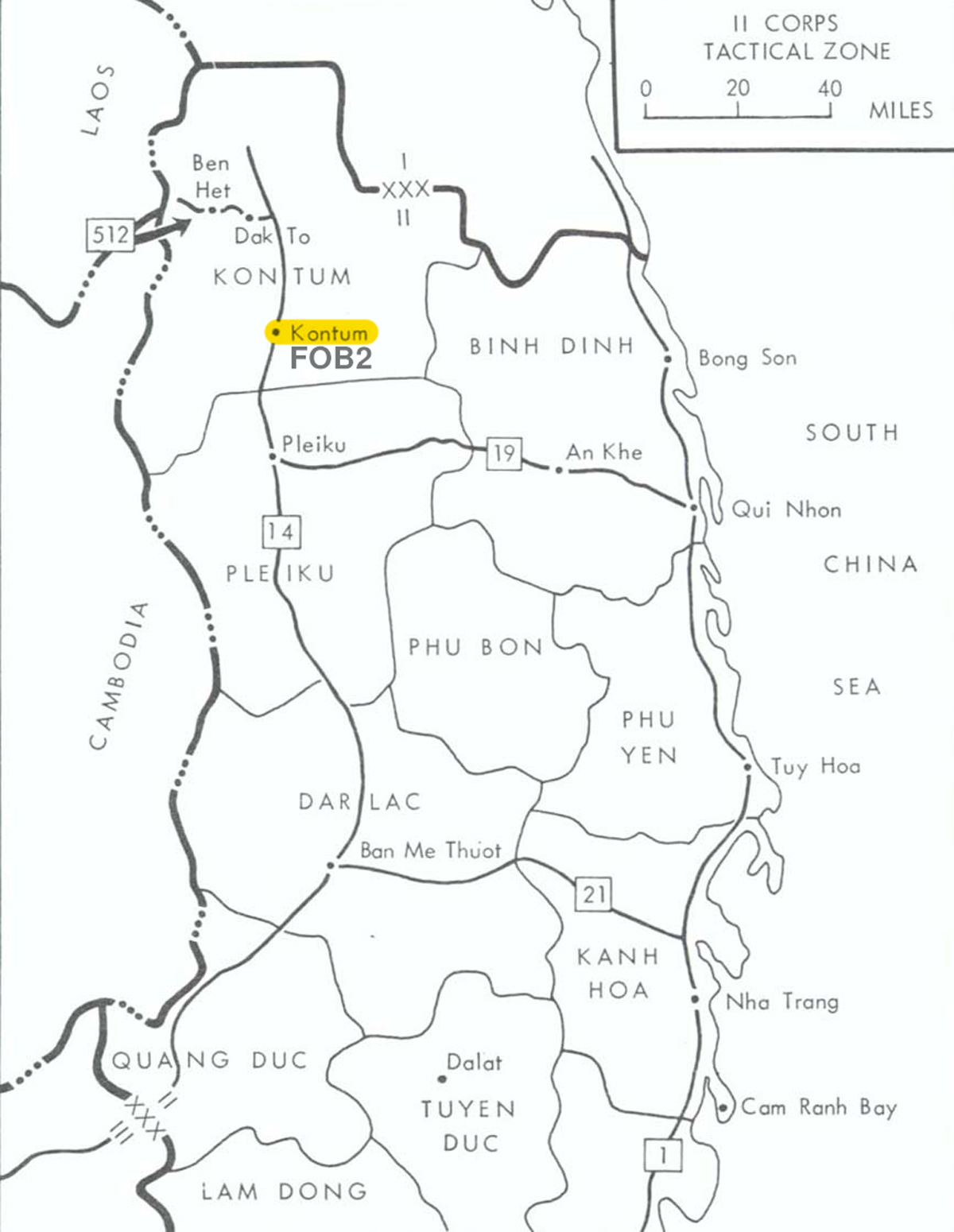
Location of FOB 2
The 3rd Cycle
A couple of days later the students for 3rd cycle arrived. With renewed enthusiasm, the entire staff really stepped up to the challenge. The cycle went very well and we went to FOB 2 with our new mobile com/op center. It performed very well. The teams did very well also. A couple of the teams made some contact. They all came through it with no injuries and had a much higher level of confidence.
Their biggest excitement was, “these IA Drills really work.” They were thoroughly impressed that everyone knew exactly what to do and their immediate and coordinated reaction totally overwhelmed the enemy unit which immediately broke contact and ran. We had the traditional “graduation ceremony” and everyone caught the Blackbird milk run back to their FOB. Because we had the mobile com/op center we had a dedicated Blackbird C-123 to get back to Long Thanh. During the flight back, the entire instructor and support staff talked excitedly about the team’s performance. To a man they were impressed that we (all of us) had really made a significant impact on these students and their ability to become a productive team member.
The 4th Cycle
When we arrived back at camp we learned that while we were gone MAJ Smathers had rotated and MAJ Ponzillo was now the camp commander. Although he didn’t spend as much time with the 1-0 School as before he was still a very strong supporter of the school and felt it was a significant part of the camp’s overall mission.
The instructor staff had an elevated attitude and were looking forward to the next cycle. They now felt they were making a major contribution to the overall mission of SOG and not necessarily being punished or banished by being on loan to the school.
The school was also gaining creditability from the FOB’s by providing quality graduates that could integrate into the teams relatively quickly. The 4th cycle went very well with hardly any hiccups. Again, we went to FOB 2 for the team missions with our mobile com/op center. We had five teams for mission in the 4th cycle and they all did very well.
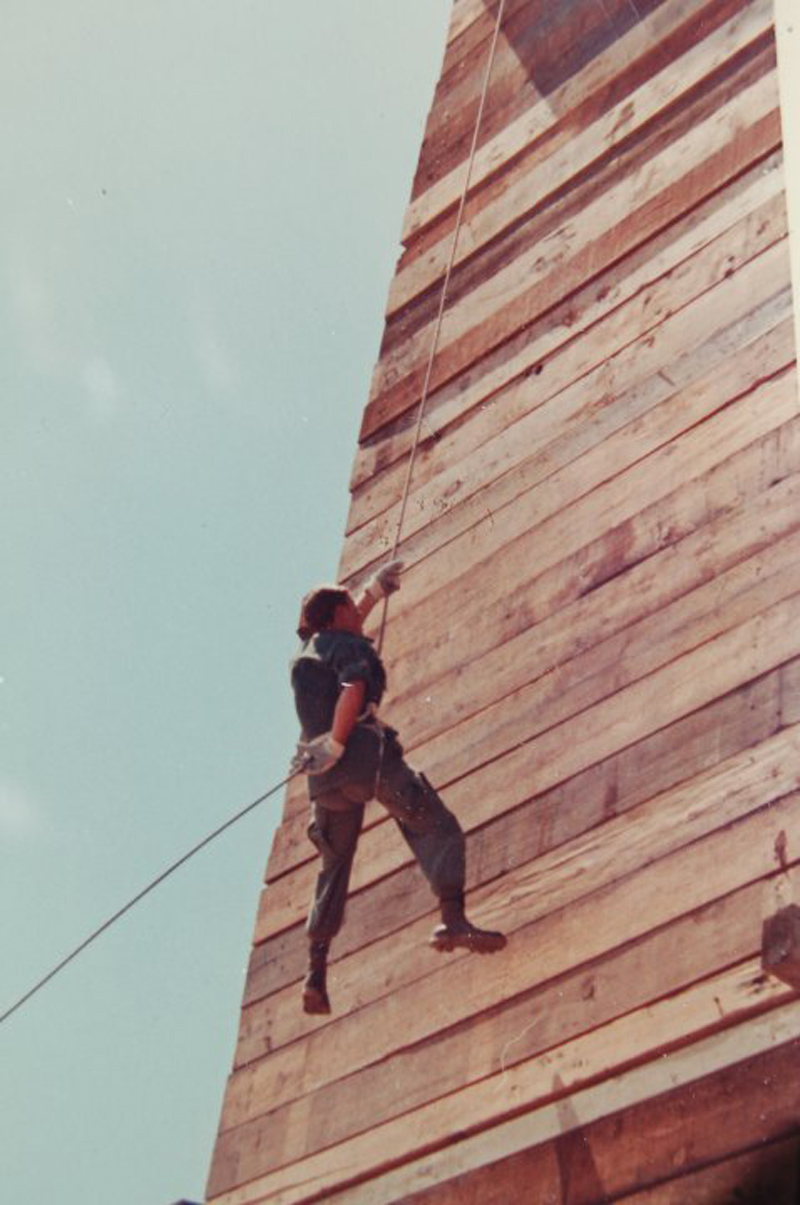
Rappelling at SOA-B53. (Courtesy of James [Jones] Shorten)
Snake Bite 1—Training Veteran SOG
When we got back from the 4th cycle, MAJ Ponzillo told me we had a change for the next cycle. SOG was going to be augmented by some TDY personnel from the 1st Group in Okinawa. There would be 28 students and the majority of them were SOG veterans from previous tours.
Even though they were mostly veterans SOG HQ wanted them to have a 1 week refresher course before going to the FOB’s. They were scheduled to arrive in 4 days. I was able to exchange telexes with CPT Wareing, the OIC for Snake Bite 1. He advised us of the subject areas that needed to be included in the refresher, so we set about redesigning the course for the 1 week schedule.
They arrived right on time aboard a Blackbird C-130. Even though they were veterans of multiple tours and to 5th Group and SOG, they were enthusiastic students. After a really good week of training we put them on a Blackbird to be distributed throughout the FOB’s.
A Reunion and Reality Check
After Snake Bite 1 departed we had about 10 days before the next cycle. I took the opportunity to go back to FOB 4. When originally sent to Long Thanh, MAJ Toomey said this school was going to run 2 or 3 cycles to get the FOB’s back up to strength and I would be back to FOB 4.
Since I was only going to be there for a short while, I left most of my personal gear at FOB 4. After my infamous conversation with COL Johnson and later with MAJ Ponzillo, I had very little hope of ever getting back to FOB 4, so I thought I should go back to collect my personal stuff plus all my personnel records were still at FOB 4. One of the instructors, SFC James (Jim) Hetrick was from there as well and went with me to take care of some personnel matters.
Once there, I spoke with LTC Isler, CCN commander (while I was at Long Thanh, OP 35 had reorganized the FOB’s into CCN, CCC, and CCS) and explained that I had hoped to get back to FOB 4. Basically I got the 2nd verse of the “Somebody has to block” speech. He said we were doing a good job at the school and all the FOB commanders had told COL Johnson they felt the school should continue because we’re still losing people and still need quality replacements. He further told me that since I only had a few months before my DROS, that if I did come back to the FOB, he wouldn’t assign me to a team. He said as an experienced CPT, you would make a much more valuable contribution to me somewhere other than being a 1-0.
I thanked him for his frankness and told him I would continue to give it my best effort in the 1-0 School. After that I went to the club to visit with some old friends, visited with some school graduates who were now active team members, gathered up my stuff and SFC Hetrick and I caught a ride to Da Nang airfield to hitch a ride with Air America back to Long Thanh.
Work in Long Thanh Continues
Back in Long Thanh, I told MAJ Ponzillo about my conversation with LTC Isler. He told me he had spoken with COL Johnson and requested that I remain at Long Thanh to which he agreed. So I was going to remain at Long Thanh until my DROS.
We received word from SOG Hq. that FOB 2 had a scheduling conflict with our next team missions and we would be doing the missions in the A/O of the Australian SAS 3rd Squadron in Nui Dat (just NE of Vung Tau). I spent the next week coordinating with the Operations Section of the SAS for air support, artillery support, etc., etc. The training cycle went well and the 4 teams were inserted in the A/O without incident. All went well during the 3 day missions, until just before the scheduled extraction. Unfortunately we experienced 1 KIA and 2 WIA in this cycle.
In the next cycle FOB 2 still had scheduling conflicts. CPT Wareing (Snake Bite 1), was working as a Liaison Officer with a special project in Dalat and had asked if we could do our team missions in his A/O. SOG said OK and so we went to Dalat for this cycle.
All went well with the training cycle and the team missions, however we did have a couple of issues. I was serving as the Covey Rider with the FAC aircraft from the Dalat airfield. Due to extremely heavy forest areas, this group had an SOP that required two aircraft go on all FAC operations. If one aircraft went down it usually broke through the triple canopy, then it closed up behind it and the downed aircraft could not be seen. The second aircraft was to stay on station to mark the spot for the recovery aircraft.
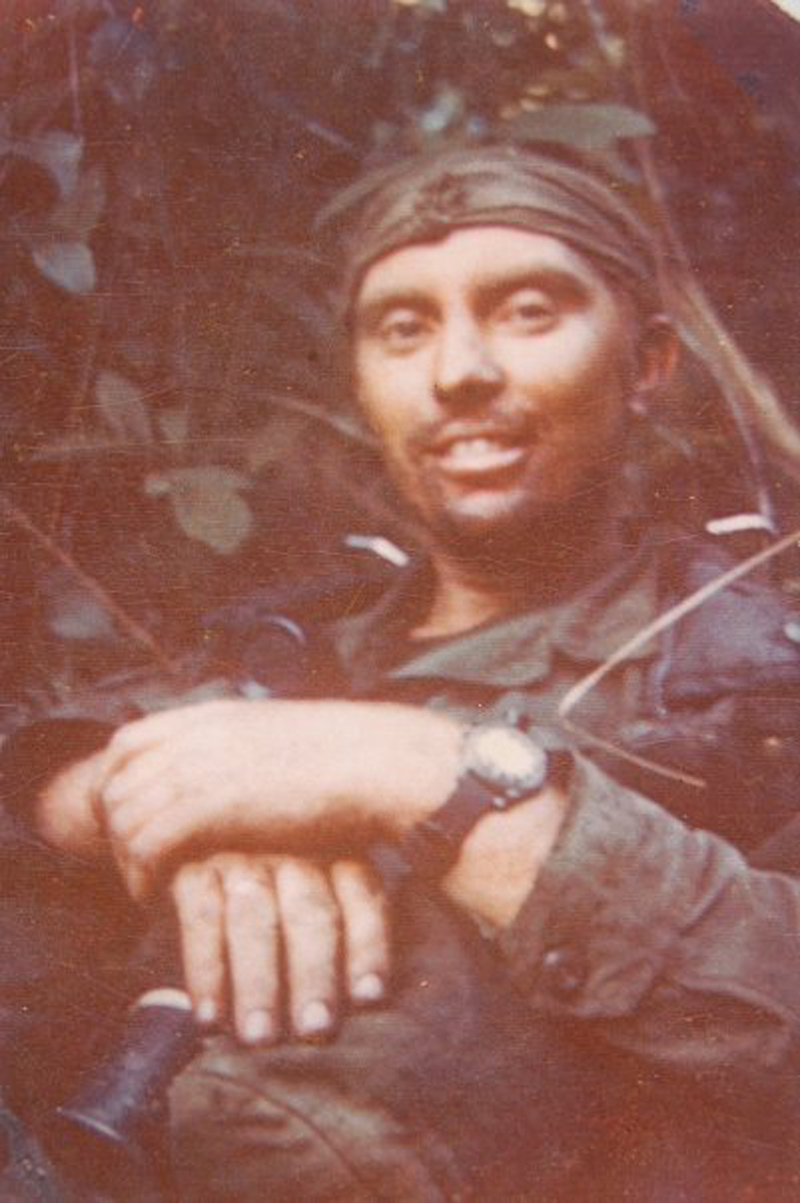
James [Jones] Shorten on a mission at SOA-B53 He was Training Officer at the One-Zero School during July through Oct 1970. Jim generously provided many of the photos for Part II and Part III of our posts for Travis Mill's story. (Photo courtesy James [Jones] Shorten)
Day Two—In the Air
On the second day, we were going out to check on the teams and I was riding in the lead aircraft. We were flying O-1’s that day. The pilot had taken on about a half load of fuel to top off the tanks before takeoff. We had been out for about an hour and I had taken reports from 2 of the 4 teams. All of a sudden the engine started sputtering and coughing and then just quit. We were at about 2,500 ft. and the O-1 has a good glide ratio, so the pilot had some time to react. He tried to restart – that didn’t work, so he switched fuel tank and tried again. After a few tries, it finally started again. It coughed and sputtered a bit, but then began to run smoothly again.
When we climbed back up to altitude he called the other ship and said we were going back and to call the operations center to send out a replacement aircraft. On the way back the pilot and I talked about what might be wrong. He said this aircraft had been very stable over the past several months, and didn’t really have any idea what may have happened. Everything went well until we were about 10 miles from the airfield. All of a sudden the engine started sputtering again.
The pilot started making adjustments to the fuel mixture and that helped some. About that time we heard the tower give clearance to the replacement aircraft for takeoff. The pilot called the tower and declared an emergency and request clearance to come straight in. They gave the OK and we’ve got the airfield in sight. By this time the engine is really coughing, smoking, and backfiring.
We were about 2 miles out we could see a big storm cloud drifting toward the airfield and at about 1 mile out we ran into the storm. Just as we hit the storm we heard an aircraft emergency beeper going off. The tower called and said they had an emergency we would have to “go around.” The pilot told them we couldn’t “go around” we probably won’t make it to the field so we’re coming straight in.
The Dalat airfield sits on top of a big hill and has steep drop offs on almost all sides, so if you come in short you hit the side of the hill plus there was an 8 ft. fence around the field. We were about half mile out, it was raining so hard I could barely see the end of the wings when the engine totally quit and all the while the emergency beeper is going off in the headset. The pilot told me to make sure my shoulder straps were tight because we may go into the side of the hill. He squeezed every inch possible — we made it over the edge of the hill, but the tail wheel hung the fence, the front wheels slammed into the ground short of the runway, blew out both tires, but the “spring” of the front gear arms caused the nose to bounce up and we came to rest right side up about 6 ft. short of the runway.
It was eerily quiet except for the emergency beeper and the sound of the rain pounding on the wings. In a minute or so the emergency vehicles arrived. We climbed out and just stood there in the rain, then the pilot said, “Any landing you can walk away from is a good one.” I whole heartedly agreed! The emergency crew told us the emergency was the replacement aircraft had crashed on takeoff.
Investigating the Aircraft Incident
The investigation revealed the night before, a new recruit driving the resupply tanker had made an error and filled the Avgas bladder with JP4. The aircraft I was in had taken on about a half load of fuel and the JP4 would float on top of the Avgas. The engine would run fine until it ran out the Avgas. The O-1 has dual wing tanks, so when the pilot switched tanks it engine ran fine again until we ran into the JP4 in the second tank. The replacement aircraft had been an O-2 and had taken on almost a full load of fuel. He had enough Avgas to take off, but hit the JP4 about 30 seconds after he cleared the fence. He tried to do a 180 and come straight back to the field, but he couldn’t maintain altitude and went into the side of the hill. Fortunately he didn’t have a lot of air speed and was able to do a slight stall and “pancake” the aircraft in the foliage to soften the impact. Both the pilot and my instructor (rider) were unhurt.
The teams still had another day on their missions and we were down to only one FAC aircraft, so we had to have a helicopter be the “spotter” so we could continue to support the teams. All went well. None of the teams made any contact, but found a lot of sites that showed evidence of recent occupation and hasty evacuation. We extracted all the teams without incident and returned back to Long Thanh. CPT Wareing told us that after we left the Mayor of Dalat got a visit from the local VC Chief. He told the Mayor that Dalat was a beautiful city and it would be a shame if it got damaged by rockets and mortars. Up until recently it had been very peaceful here but if those “intruders” kept coming to disrupt things, things could change drastically. We were never asked to come back to Dalat!
A Successful Conclusion and Transition.
By this time I was getting to within 2 months of DROS. SOG sent 1LT Dan Hall from CCS to replace me as the OIC. 1LT Hall had been a 1-0 for about 5 months and had a good track record. Once he arrived we worked together during the next cycle preparing for the transition. He was a quick study and worked well with all the instructors and camp permanent party. I went with them to FOB 2 for the team missions to introduce him to all the staff there. All went well. We completed the team missions and returned to Long Thanh. I told MAJ Ponzillo that in my opinion 1LT Hall was adequately prepared and qualified to take command of the 1-0 School. Shortly afterward we had an informal change of command ceremony and thus ended my tenure.
The 1-0 School is one of those enigmas of SOG. Very few people knew, especially the regular Army, it ever existed. Yet for all of those who went through the school and those of us who were part of the cadre, it was a very significant part of their tour. For the personnel who went through the school, there was no certificate, never recorded on their personnel file, or no badge or patch for the uniform. Many of the instructors never had official orders showing they were instructors in the school, they just showed up at Long Thanh with a letter from their FOB saying they would be there on “special duty” for xx weeks. Even though it was a “skunk works” type operation, all the instructors and staff executed their duties in an extremely professional manner. Many of the students told us later that their time in the 1-0 School was the best school they ever attended.
I think all of us (everyone in general) look back on our lives and ask the question, “Did I make a difference?” A few years ago I was visiting my brother (he spent many years in Special Forces also). He lives in the Houston area and is a member of the Houston SFA Chapter 39 and was hosting the Chapter meeting that weekend. As the members were gathering and everyone rehashing stories of long ago, I just happened to say something to the effect, “When I was at the 1-0 School.” A fellow that I had not met yet, came over and asked if I was at the 1-0 School. I said, “Yes I was.” He said, “Well, I want to shake your hand. You guys saved my life!” He said he was a first tour, new in-country E-5, assigned to CCC and had no clue what he had gotten into. He strongly felt that without 1-0 School he wouldn’t have survived the early missions. At the end of the meeting and as everyone was leaving, he came by and said “Thank You” again. That night as I was falling asleep, one of my last thoughts was, “Yes, we did make a difference.” I slept well that night.
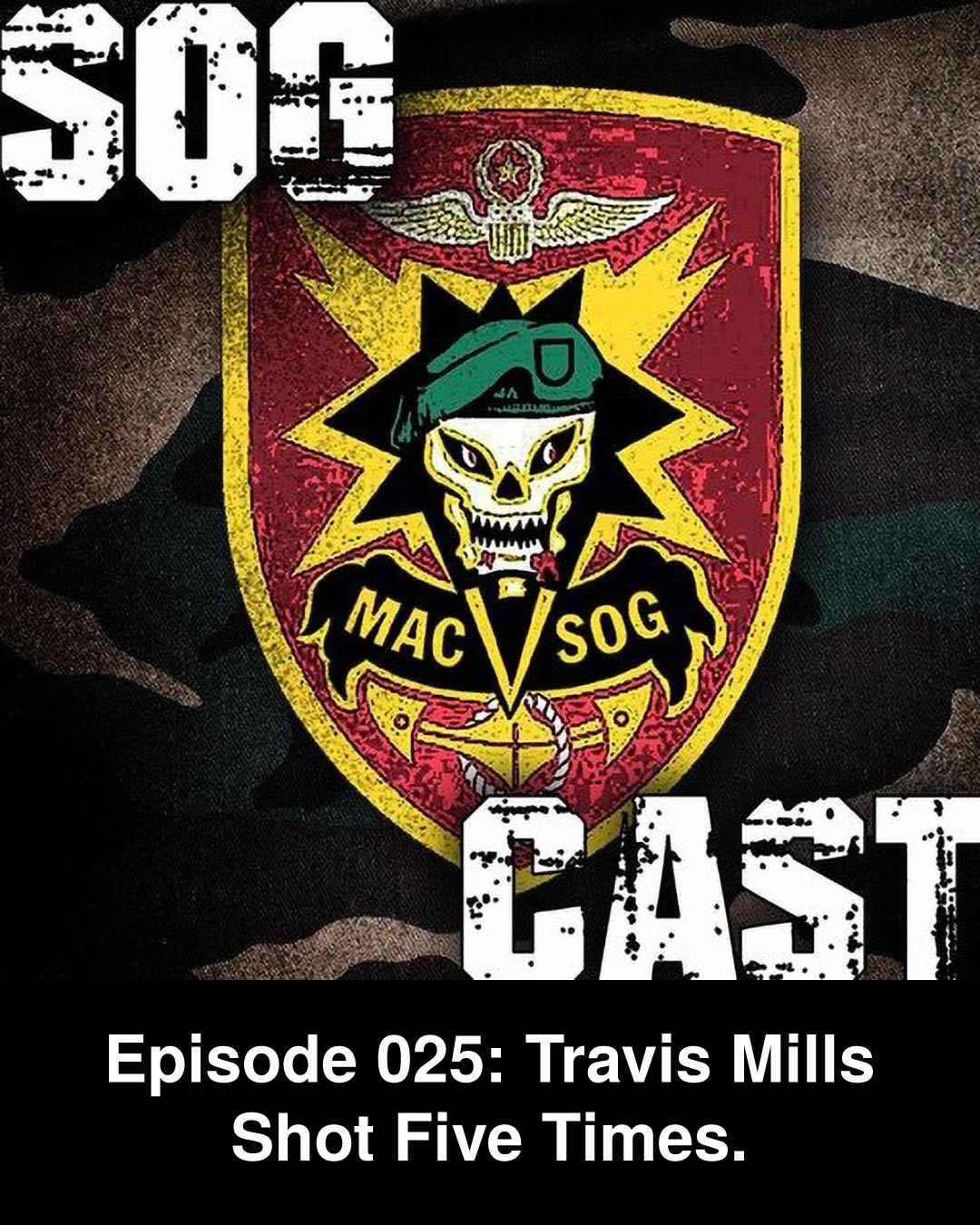
SOGCast 025: Travis Mills, shot five times and then ordered to pull guard duty!
The story of Travis Mills caught the interest of Lonny Holmes, the Sentinel's editor at the time, thanks to John Stryker Meyer. Lonny persuaded Travis to write the tale down for the sake of history. The Sentinel ran the resulting three-part piece by Travis Mills in March, April, and May 2018.
Click here to listen to Travis tell his story in this interview with John. The link will take you to the podcast on Spotify. SOGCast is also available on Apple Podcasts, and also other major sources.
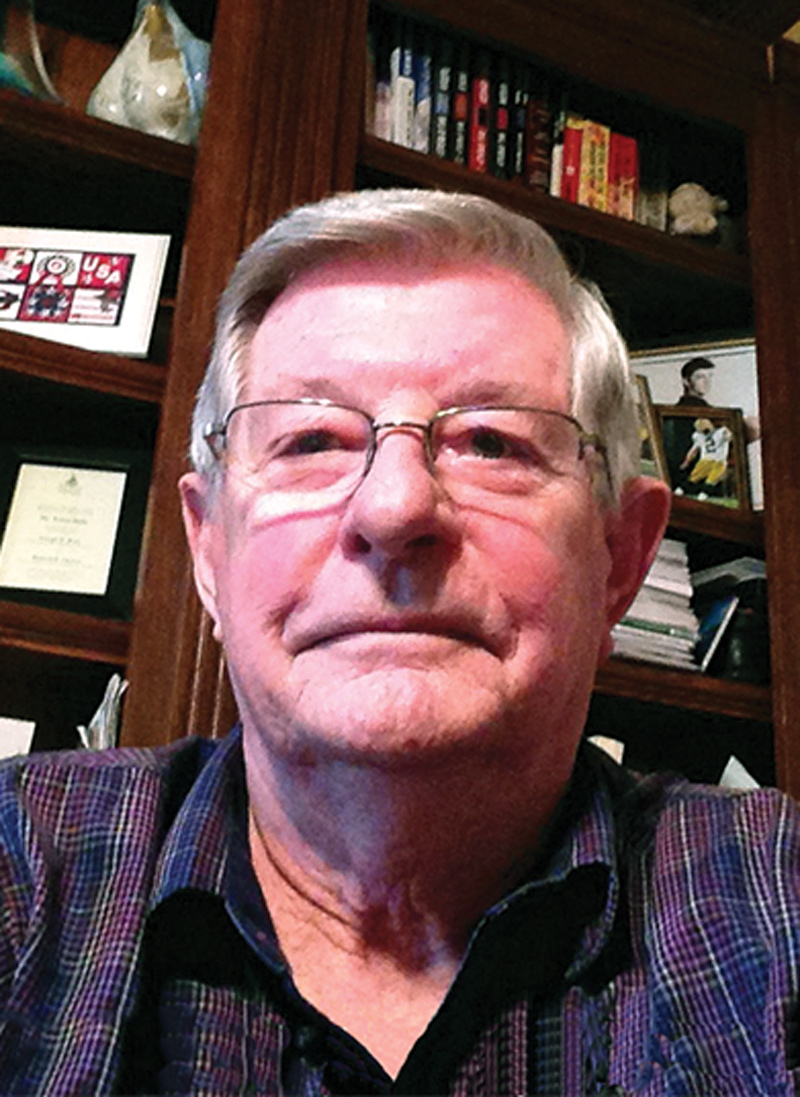
Travis-Mills-9-800px
About the Author:
Travis Mills enlisted in the U.S. Army, June 1966 — Basic and Infantry AIT. Following AIT Pvt. Travis was assigned as cadre in a basic training unit where he was promoted to Corporal. He then attended OCS at Fort Benning, GA, graduating as the Honor and Distinguished Graduate. 2nd Lt Mills next attended Jump School and was then assigned to the 7th SFGA at Fort Bragg, NC, where he completed the Special Forces Officers Course and then served as XO on an A-Team.
Receiving orders transferring him to Vietnam where he arrived in May 1968 and was assigned to 5th SFGA. Then 1st Lt Mills was assigned to MACV-SOG Command and Control in Da Nang, then to FOB 4 at Marble Mountain. Initially assigned as a platoon leader of the Hatchet Force, he was later transferred to the Recon Company and served as 1-1, 1-0 on RT Python and RT Coral.
Following discharge from the hospital for his serious wounds on August 23, 1st LT Mills was assigned TDY to B-53 in Long Thand to start the MACV-SOG One Zero (1-0) School. In June 1969 LT Mills was promoted to Captain. In December 1969 he was reassigned to 1st SFGA in Okinawa where he spent thirty months as an A-Team Commander on various missions to Korea, Taiwan, the Philippine Islands and Japan. While stationed in Okinawa he graduated from Jump Master School.
In July 1972 Captain Mills was assigned to Fort Hood, Texas. With the down sizing of the Army after the withdrawal from Vietnam Captain Mills was released from active duty and honorably discharged on November 1973.
Awards and Decorations
Bronze Star Medal, Purple Heart, CIB, Presidential Unit Citation (MACV-SOG), Vietnam, Chinese and Korean Jump Wings and the “usual” decorations and badges.
Ky Dad’s DD-214 has SOG-39 for 1964. One MACV veteran doesn’t show my Dad being on the personnel roster.
My Dad’s